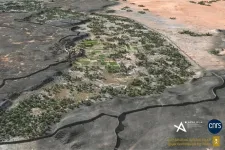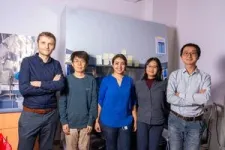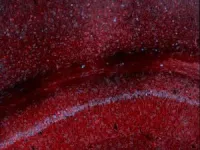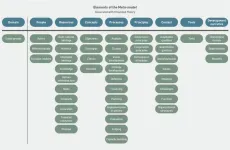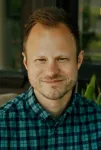Discovery of immense fortifications dating back 4,000 years in north-western Arabia
2024-01-10
(Press-News.org) The North Arabian Desert oases were inhabited by sedentary populations in the 4th and 3rd millennia BCE. A fortification enclosing the Khaybar Oasis—one of the longest known going back to this period—was just revealed by a team of scientists from the CNRS1 and the Royal Commission for AlUla (RCU). This new walled oasis is, along with that of Tayma, one of the two largest in Saudi Arabia. While a number of walled oases dating back to the Bronze Age had already been documented, this major discovery sheds new light on human occupation in north-western Arabia, and provides a better grasp of local social complexity during the pre-Islamic period.
Cross-referencing field surveys and remote sensing data with architectural studies, the team estimated the original dimensions of the fortifications at 14.5 kilometres in length, between 1.70 and 2.40 metres in thickness, and approximately 5 metres in height. Preserved today over a little less than half of its original length (41%, 5.9 km and 74 bastions), this colossal edifice enclosed a rural and sedentary territory of nearly 1,100 hectares. The fortification’s date of construction is estimated between 2250 and 1950 BCE, on the basis of radiocarbon dating of samples collected during excavations.
While the study confirms that the Khaybar Oasis clearly belonged to a network of walled oases in north-western Arabia, the discovery of this rampart also raises questions regarding why it was built as well as the nature of the populations that built it, in particular their relations with populations outside the oasis.
This archaeological discovery, whose results will be published on 10 January in the Journal of Archaeological Science: Reports (JASREP), paves the way for major advances in understanding the prehistoric, pre-Islamic, and Islamic past of the north-western Arabian Peninsula.
Notes
1 – From the Orient and Mediterranean Laboratory (CNRS/Collège de France/EPHE-PSL/Sorbonne Université/Université Panthéon-Sorbonne) and the Archéorient – Environments and Societies of the Ancient East Laboratory (CNRS/Université Lumière Lyon 2), in connection with the Khaybar Longue Durée Archaeological Project commissioned by the French Agency for AlUla Development (AFALULA) for the Royal Commission for AlUla (RCU).
END
ELSE PRESS RELEASES FROM THIS DATE:
2024-01-10
A new paper in Molecular Biology and Evolution, published by Oxford University Press, finds that HIV populations in people with higher viral loads also have higher rates of viral recombination. In effect, the more HIV in the blood, the easier it is for the virus to diversify.
One of the reasons HIV has historically been so difficult to combat is the virus’s exceptionally high rate of recombination. Recombination enables the exchange of genetic information across strains of the virus and drives HIV’s evolution within people. This genetic exchange ...
2024-01-10
With tens of thousands of synthetic chemicals on the market, and new ones in development all the time, knowing which ones might be harmful is a challenge both for the federal agencies that regulate them and the companies that use them in products. Now scientists have found a quick way to predict if a chemical is likely to cause breast cancer based on whether the chemical harbors specific traits.
“This new study provides a roadmap for regulators and manufacturers to quickly flag chemicals ...
2024-01-10
The intense changes in our modern society and the associated challenges are constantly increasing, not least due to the meta-crisis of climate change. Yet our approach to cultural heritage is still strongly influenced by the narrative of preservation. The article aims to find solutions within the interplay of preservation and change. Based on the psychological impact on society resulting from the current challenges, it is argued that cultural heritage experts need competencies in dealing with uncertainty and tolerance of ambiguity in order to provide security of action. The article applies insights from multiple disciplines to urban environment studies and advocates for a systemic understanding ...
2024-01-10
Tore Olsson put his students in touch with American history through his popular and award-winning class “Red Dead America: Exploring America’s Violent Past Through the Hit Video Games.” Now this engagement has reached beyond the classroom—the historical profession’s most prestigious journal, the American Historical Review, just published a major feature on the class as an example of creative and innovative history teaching.
Olsson is an associate professor and director of graduate studies in UT’s Department of History. His focus as a historian is the United States since the Civil War, with a particular interest in the US South, ...
2024-01-10
Infrared vibrational spectrum of a single protein is observed using advanced measurement techniques based on near-field optical microscopy. This method utilizes light confined at the nanometer scale, allowing for the detailed analysis of extremely small samples, which was previously challenging with conventional infrared spectroscopy. The achievement represents a major advancement towards technological innovations such as ultra-sensitive and super-resolution infrared imaging, as well as single-molecule vibrational spectroscopy.
Infrared ...
2024-01-10
New research from the Institute of Psychiatry, Psychology & Neuroscience has found an association between a reduction in grey matter in the brain and Early Onset Psychosis (EOP).
The study, published in Molecular Psychiatry, is the largest ever brain imaging study in EOP and has provided unprecedented levels of detail about the illness. It shows that, in contrast to other mental health disorders, people with EOP have a reduced volume of grey matter across nearly all regions of their brain. Researchers hope that this detailed mapping ...
2024-01-10
Novel findings from a preclinical head-to-head comparison show that administering a COVID-19 vaccine as a nasal spray rather than a subcutaneous injection enhances the body’s long-term immune memory, thereby increasing the vaccine’s overall effectiveness.
This research could pave the way for a COVID-19 vaccination strategy that depends on fewer boosters to achieve the same level of protection against SARS-CoV-2 viruses.
SINGAPORE, 10 January 2024 – A team of scientists, led by Duke-NUS Medical School, has discovered a potential intranasal vaccine candidate that provides improved, ...
2024-01-10
DURHAM, N.C. – Adults with posttraumatic stress disorder (PTSD) have smaller cerebellums, according to new research from a Duke-led brain imaging study.
The cerebellum, a part of the brain well known for helping to coordinate movement and balance, can influence emotion and memory, which are impacted by PTSD. What isn’t known yet is whether a smaller cerebellum predisposes a person to PTSD or PTSD shrinks the brain region.
“The differences were largely within the posterior lobe, where a lot of the more cognitive functions attributed to the cerebellum seem to localize, as well as the vermis, which is linked to a lot of emotional processing ...
2024-01-10
Psilocybe fungi, known colloquially as “magic mushrooms,” have held deep significance in Indigenous cultures of Mesoamerica for centuries. They captured the wider world’s attention as a psychedelic staple in the 60s and 70s. Now, these infamous organisms are at the forefront of a mental health revolution. Psilocybin and psilocin, the psychoactive compounds found in nearly all species of Psilocybe, have shown promise as a treatment for conditions including PTSD, depression, and for easing end-of-life care.
To ...
2024-01-10
A sex-specific panel of 10 proteins can pick up 18 different early stage cancers, representing all the major organs of the human body, finds a proof of concept study published in the open access journal BMJ Oncology.
The findings could kick-start a new generation of screening tests for early detection of the disease, say the researchers, particularly as there are many sex specific differences in cancer—including age at occurrence, cancer types, and genetic alterations—points out a linked editorial.
Cancer accounts for 1 in every 6 deaths around the globe, with nearly 60% of these deaths ...
LAST 30 PRESS RELEASES:
[Press-News.org] Discovery of immense fortifications dating back 4,000 years in north-western Arabia
